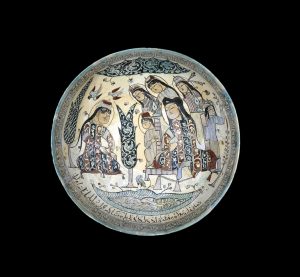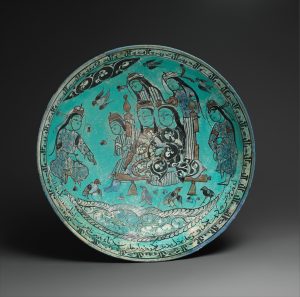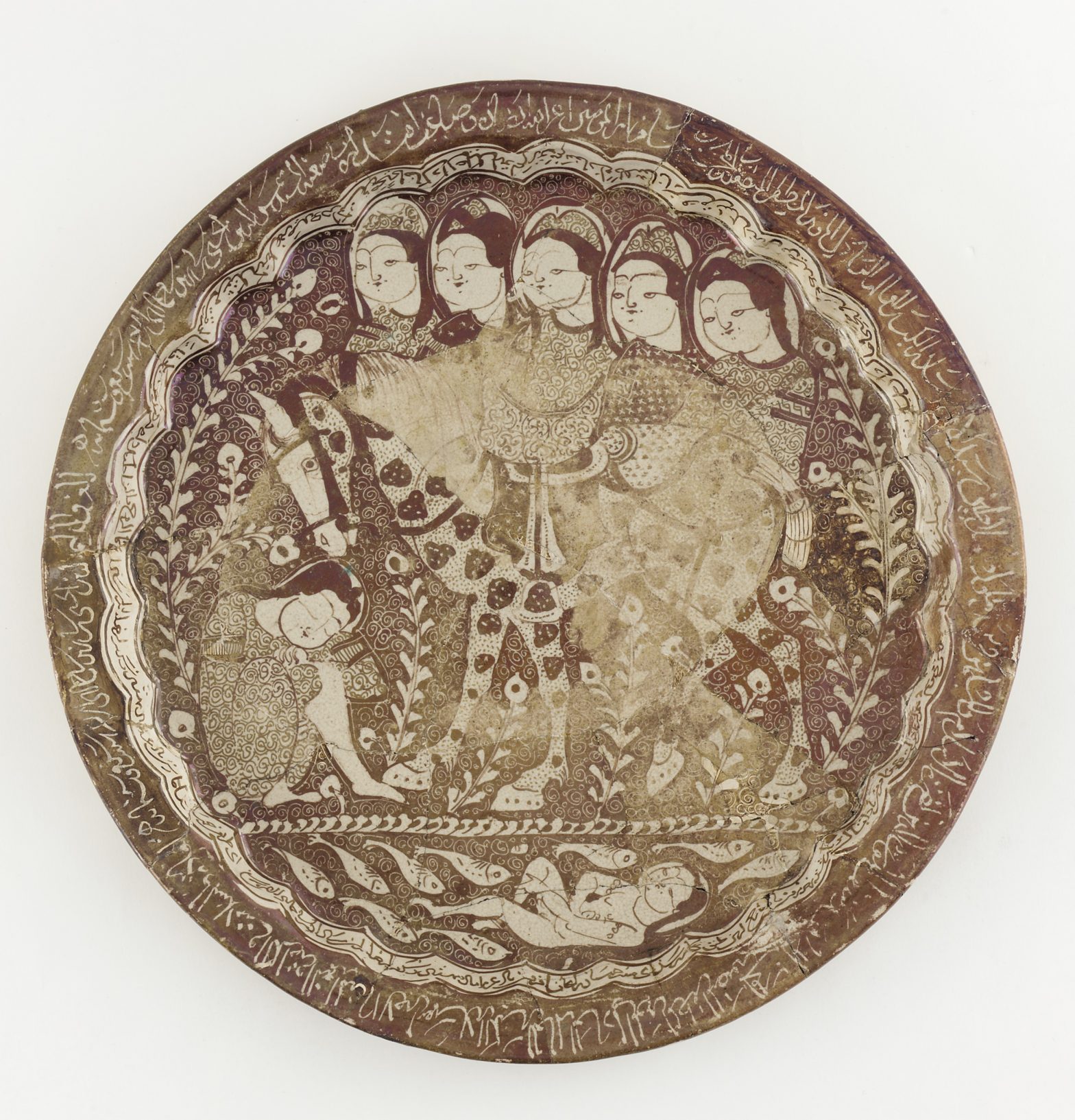The inhabitants of Kashan a town in Northwestern Iran have long produced pottery for thousands of years. Its fine clays and elaborate system of underground water channels (qanat) made the region an ideal setting for this craft. Further, Kashan and its surrounding areas are blessed with the deposits of silica, bentonite and even kaolin that are found in fine medieval stoneware ceramics.
Kashan had an excellent education system that produced distinguished civic administrators. One of the virtues for which its scholars were highly regarded was their mastery of Arabic and Persian calligraphy.
The Saljuq period of rule in Iran (1040-1195) saw the rise of the Kashan as a major centre of luxury ceramics, producing some of the finest known works of art in the medieval world.
Abu Zayd al-Kashani
Abu Zayd al-Kashani was a Persian potter and poet who lived and worked in Kashan. The earliest known work by Abu Zayd is a mina’i bowl in the Metropolitan Museum of Art dated to 1186. His last known work is a lustre bowl in the Gementeemuseum in the Hague dated (1219-1220). The early bowl is a considered a highly accomplished work suggesting that Abu Zayd would have been honing his craft prior to 1186.
Working in the overglaze techniques of Persian mina’i and lustre on stoneware, he left more signed works than any other Persian potter. Both techniques share certain features, such as their second firing and the appearance of Central Asian personages. A few of his luxury ceramics will be examined in this article, it is hoped the reader can gain an understanding of the life and times of Abu Zayd.

The above scalloped plate at the Freer Gallery of Art is a famous example of Kashan lustre and attributable to Abu Zayd and is considered an exemplary work of Persian medieval art. The plate is composed of fritware – a type of ceramic body created and perfected in the Islamic world in response to the strength and luminosity of imported Chinese porcelain.
Lustreware on tin-glazed fritware, reached an apex in Fatimid Egypt during the twelvth century. This phenomenon was illustrated in my article ‘Ceramic Arts of the Islamic World’. Potters migrating to Egypt from Iraq in the tenth century made important innovations in production methods that altered the course of ceramic history. Following the fall of the Fatimid dynasty these potters seem to have migrated to Syria and Iran taking their designs and production techniques with them.
The scene in (Fig1) depicts what appears to be a maiden bathing in a pond surrounded by nine fish. Seated on the bank to the left is a man bowing his head and in the centre is a horse surrounded by five maidens. Abu Zayd applied lustre paint to the plate and then carefully scratched the surface and painted fine details in reverse to achieve the desired composition. This would have been an expensive and time-consuming process in terms of materials, labour and double firing. The museum record reads the images as a mystical allegory regarding the quest for the Divine;
‘According to this interpretation, the sleeping youth represents the mystic who yearns to transcend the material world, symbolized by the horse. The youth’s goal is to attain a vision of divine beauty (i.e., union with God), signified here by the naked woman floating in the fishpond. It is the only known extant plate with such an unusual and spiritually inspired iconography.’
This description above is most likely based on Grace Guest and Ettinghausen’s article, The Iconography of Kashan Lustre Plate, Ars Orientalis, 1961. Whilst we have little in the way of contemporaneous records to shed light on the significance of the pictorial scheme, we can assume that Abu Zayd was conveying an unknown source of poetry or literature. The plate certainly reflects a sophisticated and highly literate craftsman and society.
Western Collectors of Kashan Style Ceramics
Lustreware ceramics at the time of their discovery by archaeologists working in Iran were highly sought after by 19th century Western collectors, often fetching astronomical sums at sales or auctions. The passion for highly decorated pottery, in the 19th century was in part a manifestation of the ‘arts-and-crafts’ aesthetic in which Islamic pattern was particularly admired. William Morris the designer would refer to Islamic ornament in his designs. The potter William Morgan also familiarised himself with the works of Islamic potters and influences can be observed in his lustre works.
Mina’i Ware
The other type of ceramic, mina’i wares were also produced concurrently, however failed to attract the same type of initial interest as lustrewares. Interest however did pick up by the 20th century.

Mina’i is a category of ceramics that are unique to Kashan and invented through creative experimentation, by the same potters who perfected lusterware. Mina’i , correctly referred to as haft rang (seven colours) involves the painting of coloured pigments over an earlier glazed and fired body. They were fired a second time following decoration with blue, turquoise, reddish brown, manganese purple, green, brick red, black and white enamel. The majority of mina’i wares were decorated over a white glazed background, though there are examples decorated over turquoise background.
The above bowl at the British Museum has been attributed to Abu Zayd. It features an enthroned male to the right hand side of the bowl, surrounded by five maidens. To the left of a central cypress tree is a seated figure and what appears to be a pond at the base of the bowl. The faces and dresses appear Central Asian as the Seljuk rulers were of Turkic origin. The inscriptions have not been deciphered to my knowledge, however, most likely were verses composed by potter himself.
Abu Zayd the Poet

Fig. 3. Abu Zayd al-Kashani Bowl, dated A.H. 582/ A.D. 1186 Islamic, Seljuq period (1040–1196) Stonepaste; polychrome inglaze and overglaze painted on opaque monochrome glaze (mina’i) The Metropolitan Museum of Art, New York, Fletcher Fund, 1964 (64.178.1)
Abu Zayd was a man of many talents as can been inferred from his ceramic works. In addition to his artistic creativity in pottery he was a man of the pen and composed poetry that adorned his ceramic works.
A fine bowl (Fig.3) at the Metropolitan Museum, New York painted in both mina’i and lustre but this time on a turquoise background features an enthroned figure seated by courtiers in what appears to be a majilis (literary) event. The verses inscribed on the vessel have no direct association with the image depicted, however are verses of poetry composed by Abu Zayd. On reading the verses, we can assume that the orator to the left of the bowl gives voice to these poetic verses;
Inscription:
ای تن غم عشق به کزینت نکند
… بجان و دینت نکند
در دام عافیت (عاقبت) شکر پای هوس
تا عشق سزاوار آستینت نکند
‘Oh body, the sorrow of love will not make you any better [than this]
Will not [help]…. your soul and faith
At the end, the sweetness of lust will entrap you
So that, love will not make a fool of you’
Outside:
دیدی که چه کرد برف با ما یارا
ای برف بگفتمی ولی گو یارا
بر آتش عاشقان … و سرد
تو هم گرم گرفتی مارا
‘Oh beloved, Did you see what the snow (white hair) did to me?
Oh snow (white hair), you told me but tell my beloved
….to the passion (fire) of lovers ….and cold[?]
And you are still flirting with me…’
قائله کاتبه ابو زید بعد ما عمله کتبه فی یوم الاربعاء الرابع من محرم سنه اثنی و ثمانین و خمسمائة هجریة عربیة بقا لصاحبه و کاتبه
‘Abu Zayd himself made it and composed it, Wednesday, 4th of Muharram 582 A.H. Longevity to the owner and poet.’
Inscriptions source: the Metropolitan Museum of Art
Therefore, not only was Abu Zayd a master potter and painter he was also a passionate poet and keen to show of his poetic skills at any given opportunity, so it seems.
Stylistic Analysis
The vessels examined so far, exhibit obvious Central Asian influences in its style of imagery. They feature slender moon-faced personages framed by long tresses of hair, almond eyes, delicate noses and small mouth – features associated with the ideals of Turkic beauty in poetry and literature of the time. The gender of the figure is at times indistinguishable, since both Seljuk men and women appear with long locks of hair low hats, and tiraz bands, on their sleeves.
The art historian, Yuka Kadoi has argued however that there is substantial evidence for the artistic impact of China on the painting tradition in Iran from as early as the beginning of the eleventh century. She ascertained there was a fashion for the moon-face (māhrū) in the twelfth and thirteenth centuries in painting across a variety of media and that māhrū became associated with ideal beauty during the spread of Buddhism, and that this may be that the origin of the seated moon-faced figures with enigmatic hand positions, reminiscent of mudras, even if the meaning did not translate into the Islamic workshops of Kashan.
Abu Zayd
There are no known historical records that shed light on Abu Zayd. We know from reading inscriptions on his ceramics that Abu Zayd came from an important sayyid family, that he was a descendent of the Prophet’s son, Ali. His signature is found on both tiles and vessels executed in both lustre and mina’i, two very expensive and highly technical areas of craft. Abu Zayd was not only a potter, he was also a poet and composed and transcribed poetic verses onto his works. In many ways he exemplifies the literary culture (adab) of medieval Persia in which composition and oral quotation in a communal setting was deemed a mark of literary accomplishment.
Abu Tahir Family of Kashan
The Abu Tahir family were another Sayyid family of Kashani potters who were central figures in the Kashan ceramic industry during the 13th and 14th centuries and dominated Kashan lustre production well into the first half of the 14th century. Abu Zayd collaborated with the head of the Abu Tahir family, Muhammed ibn Abi Tahir in both mina’i and lusterware on tiles on two of the most important lusterware projects of the period, the decoration of the tomb chambers in the shrines at Qum and Mashhad.
Abu l’ Qasim and his important thirteenth century treatise.
Abu l’Qasim was a member of the Abu Tahir family and served as a historian at the Ilkhanid court and wrote a history of the Ilkhanid ruler Uljaytu (r. 1304-16). He wrote a treatise on ‘The Virtues of Jewels and the Delicacies of Perfumes’ in A.D 1300 that included a chapter on the art of ceramics, which he described as a “kind of alchemy”. He describes materials, techniques and the ceramic making process in quite some detail. Interestingly he discusses fritware rather than clay-bodied wares. Clay-bodied wares continued to be produced however fritware was considered a luxury ceramic destined for important vessels or architectural tiles.
This manuscript survives today and is a valued document that describes ceramic production through the insight and scholarship of a member of an important family. Although the treatise is in part drawn from earlier works on stones and gems by Jawhari al-Naṣir al-Din Tusi, who was in turn inspired by al-Biruni (and ultimately by Aristotle), it does contain an original section about the manufacture of Kashan luster and mina’i ware.
One can deduce therefore that the production of overglaze ceramics in Iran from the late twelfth to the mid-fourteenth century was passed down through families. In the case of Kashan, it seems to have been the monopoly of a very few families of prominent, learned Shiites.
Abu Zayd was part of an exclusive circle of potters in medieval Iran and was no doubt highly literate and inclined to share his poetic compositions with observers of his ceramic works.
This essay is indebted to the scholarship of Sheila Blair in her article; A Brief Biography of Abu Zayd, 2008.
